Treatment of nail fungus with folk remedies is a long process that can take from 1 to 4 months. At the same time, it is possible that after some time there will be a recurrence of the disease. This is due to the high level of infection of the microorganisms that cause this pathology, as well as the spread of their spores in the environment where the infected person lives.
What is Nail Fungus
Fungus on the nail plate on the toes is an infectious disease with a chronic form that occurs as a result of infection of this part of the body with a pathogen (fungus). In medical terminology, this pathology is defined as onychomycosis.
It is considered a common disease that is difficult to treat with all types of therapy.On average, every 10th resident suffers from toenail fungus. The disease can turn into an intricate form, which affects the entire surface of the nail plate, causing its detachment and deformation.
Types of toenail fungus
Treatment of toenail fungus using traditional medicine is a long process, and positive results can be achieved after 1-3 months. from the beginning of therapy. The diversity of mycosis is also very important, its development has led to the defeat of all or part of the nail plate.
The table below shows the types of toenail fungus, as well as a description of the pathological process:
| Types of onychomycosis | Characteristics of the disease |
| Normotrophic | The color of the nail plate changes. Elongated lines and irregular spots may appear. At the same time, the normal luster of the nail, the transparency of the plate and its normal thickness can be preserved. It is considered a mild type of disease that responds well to treatment with traditional medicine. |
| Hypertrophic | The color of the nails changes, the luster and transparency disappear. The gradual deformation of the nail plate develops with the destruction of the edges. Fixing the nail part of the bed is possible. The degree of plate deformation directly depends on tissue insemination by pathogenic microorganisms. |
| Onycholytic | This is a type of atrophic disease, when the stage of deformation of the nail plate is complete. The nail tissue dies, which eventually leads to its rejection from the root of the bed. |
This classification of the diversity of onychomycosis species is used by dermatologists.
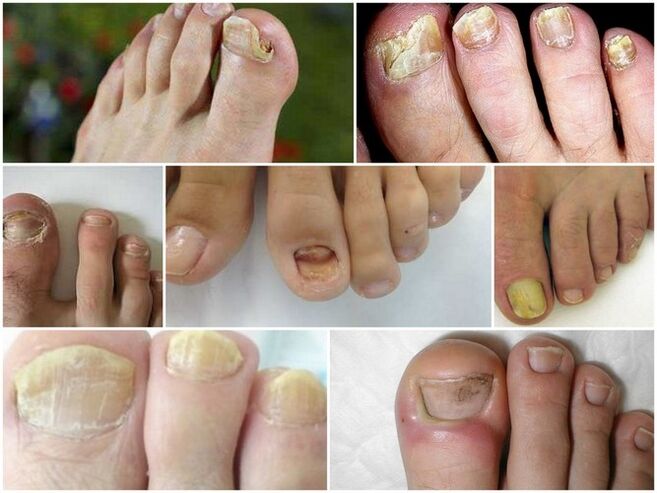
Also, the disease is divided according to the signs of the clinical picture, namely:
- distal - damage to the nail nails occurs only from the free edge;
- lateral - nail destruction develops laterally;
- proximal - mycosis damages posterior ridge tissues;
- total - the fungus has affected the entire nail, from the root to the front.
The type and form of the disease is determined by a specialized specialist at the time of examination of the patient. Based on the results of examination and diagnosis, a treatment regimen is selected. This applies to both methods of drug therapy and folk remedies.
Levels and degrees of toenail fungus
Nail fungus, treatment with folk remedies that takes a long time, is a chronic disease. Onychomycosis develops over several months, and sometimes even for years. It depends on how strong the patient's immune system is, as well as from the strain of the infectious pathogen.
Each stage of the disease is characterized by a gradual deterioration in the health of the affected tissues, namely:
- Stage 1-there is a gradual change in the color of the nail plate along its edges, the formation of lines and spots of white, gray or yellow color is possible, signs of other painful diseases are not at allthere (a person senses a sharp and unpleasant smell of yeast coming from the toes);
- Stage 2-onychomycosis takes place, covering the entire area of the nail plate, its structure begins to change from the edges to the base of the bed (the color of the diseased tissue is completely yellow or gray, there are no signs of transparency);
- Stage 3 - the last stage in the development of toenail fungus, characterized by complete necrosis of the affected tissue, it is deformed and rejected by the body (the appearance of local inflammation caused by the release of nail plates from the base of the bed is possible).
The last stage of the disease is the most severe form of onychomycosis. After nail rejection, remodeling occurs, but in this case, healthy tissue is already formed. If a person does not take steps to treat dermatological diseases and get rid of pathogenic microorganisms, then new nails will also be infected with mycosis and crumble to the ground.
Symptoms of Nail Fungus
Nail fungus, a treatment with folk remedies that requires the regular use of decoctions, tinctures and homemade ointments, is a disease with significant symptoms.
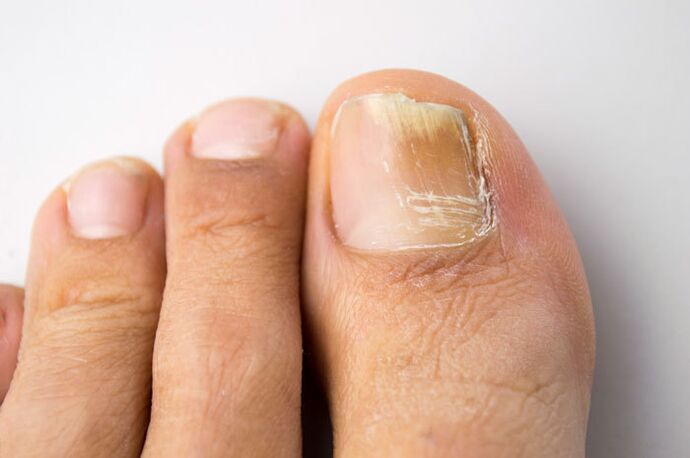
Onychomycosis of this part of the body can be identified by the following symptoms:
- redness of epithelial tissue located around the circumference of the nail plate;
- white spots or lines appear on the sides of the nail, as well as on the front of the nail, which do not disappear during plate machining or taking water procedures;
- nail plate gradually changes color, there is a loss of its transparency (pathological process develops from the edges to the center and roots of the tissue);
- Fungal microorganisms penetrate deep into the nail plate, destroying its structure, leading to its deformation;
- the affected nail has a yellow wrinkled shape;
- under mechanical action on the affected tissue, it is separated from the nail bed (this process can be accompanied by painful symptoms and secretion of ichor at the root of the nail, where it connects with the epithelial and soft tissues of the toes).
All of the above symptoms are accompanied by a persistent unpleasant odor and an unpleasant odor, which resembles yeast, but is more pronounced. Signs of the disease appear even before external symptoms begin to develop, indicating the gradual destruction of the nail plate tissue.
Causes of toenail fungus
Fungus on toenails, a treatment of folk remedies based on the principle of systemic use of home remedies, can not grow by itself without the influence of a number of factors.

Infection with onychomycosis may occur in the following cases:
- as a result of visiting public baths, showers, steam rooms, swimming pools, saunas, if a person does not use individual rubber slippers, in contact with surfaces where there are many spores of fungal microorganisms;
- shoes are worn by some people, when one of them has a mycotic lesion on the nail plate;
- poor hygiene, occasional foot washing;
- the presence of concomitant diseases such as diabetes mellitus, varicose veins, as well as foot deformities, increases the risk of toenail fungus, when local immunity is decreased, or a nutrient medium is created to increase the population of fungal microorganisms;
- wear shoes made of low -quality lining that do not allow air to enter and do not absorb water, which ultimately causes the toes to be constantly damp;
- contact of the open part of the foot or nail with the floor surface in the apartment, if a person with onychomycosis lives in the same living conditions.
A person's immune status plays an important role in the development of this disease. People with strong immunity can prevent infection and damage to the nail plate. A warm and humid environment is ideal conditions for fungal microorganisms, so this information should be taken into account when visiting beaches and other crowded places.
Diagnosis of toenail fungus
Fungus on toenails, treatment with folk remedies that begins only after a detailed examination by a dermatologist, is an infectious disease that requires careful diagnosis. This is necessary to determine the strain of fungal microorganisms, and then select a treatment regimen that will be effective in a particular case.

For the diagnosis of onychomycosis, the patient must undergo the following stages of examination:
- initial examination by a dermatologist who examines the appearance of the affected plate, assesses the condition of the tissue, the degree of its deformation;
- smears were performed from the surface of the epithelium located around the nail bed (biochemical analysis was performed for strains of fungal microorganisms, as well as the possible presence of secondary bacterial microflora);
- in laboratory manipulation room conditions, specialists select the affected part of the tissue to study fungal microorganisms in more detail and exclude the simultaneous presence of several types of mycosis;
- In addition to the toes, an examination of the skin surface of the feet is performed to ensure that the fungal disease is localized and there are no signs of its spread to other parts of the lower limbs.
Based on the results of external examination, as well as based on laboratory findings, the attending physician diagnoses the patient - onychomycosis, or rules out the presence of pathology.
Diagnostics take an average of 1 to 3 days. In public hospitals, biochemical laboratory services are free, but the conditions for studying biological material can last up to 7-10 days.
When to see a doctor
Consultation with a dermatologist should be done as soon as signs of nail fungus have been detected.Delays are fraught with worsening symptoms and damage to large areas of the nail plate.
In addition, a person with signs of onychomycosis is a carrier of a fungal infection, and also, without realizing it, spreads spores of pathogenic microorganisms in everyday conditions in his or her residence. In this case, infection of a healthy family member with onychomycosis is not excluded.
Nail Fungus Prevention
It is possible to avoid contamination of toenails with fungal infections, but for this, simple preventive rules must be followed daily, which will protect the lower limbs from insemination by pathogenic microorganisms.

The following actions are recommended:
- do not visit public baths, swimming pools, saunas, showers, or wear rubber soles on your feet;
- only wear high quality shoes made of genuine leather;
- follow the rules of personal hygiene, wash feet daily with warm water and soap, wash socks;
- insisted on treating family members who had signs of toenail fungus, but let the disease continue and did not seek medical help;
- during summer vacations near open bodies of water, on the beach, walk only with shoes, avoiding the epithelial surface of the feet and toes with sand, river silt or soil;
- wear your own shoes;
- make sure that there are no areas of mold growth in apartments or private homes (moisture on the walls, fungus infecting old wooden floors, floorboards, blackening of wallpaper in corners).
To prevent nail infections on the nails, it is recommended to pay special attention to strengthening the immune system.
To do this, you need to bathe in contrast every day, give up bad habits, harden the body, eat rationally, eat only biologically useful products (cereals, chicken, rabbit, turkey, veal, fruitsfresh, vegetables, herbs, cottage cheese, milk, cheese, sea fish).
Methods for the treatment of toenail fungus
Onychomycosis therapy is performed using traditional medicine, traditional medicine recipes, and also performed with surgical intervention methods. Each of these methods is effective to some degree in the development of the disease.
Medicine
Treatment of fungal infections is done with drugs that have a spectrum of antifungal action.
Antifungal medications can only be prescribed by a dermatologist. Only a specialist of this profile can determine which drugs are effective in a particular clinical case. In addition, when formulating a treatment regimen, laboratory study data on samples collected from deformed or altered nails are considered.
Traditional methods
There are traditional medicine recipes that allow you to get rid of fungal infections on toenails without the use of pharmaceutical preparations. To do this, use the following compresses, homemade ointments, tinctures and other methods:
Compress Kombucha
To prepare this traditional medicine, you need to buy kombucha, or grow it yourself at home. A piece of this material is cut with a knife and then placed on the surface of the infected nail. The procedure is performed at night before bedtime. Kombucha glued to the fingers with adhesive tape. The timing of therapy is not limited by time.
Onion Juice Tincture
You need to take 1 medium -sized onion, cut it with a knife, and then pour 1 tsp. granulated sugar.
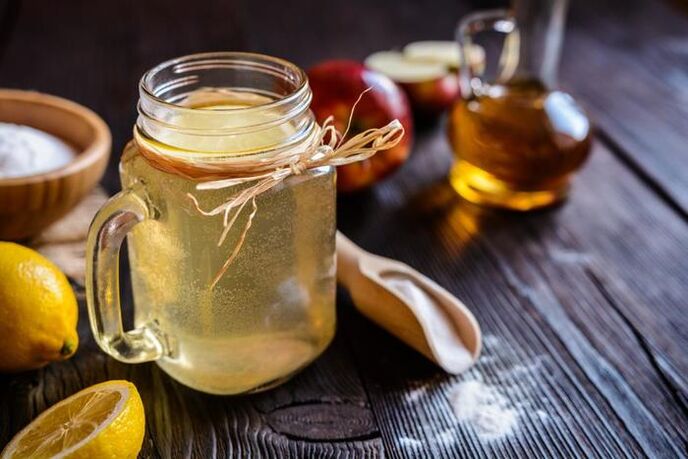
Future medicine is delivered to the refrigerator for 24 hours. During this period, the chopped vegetables successfully produce sufficient juice, which is incorporated and then used as medicine. Sick nails are rubbed with onion juice 3-4 times a day for 3 months, or until full recovery.
Antiseptic solution
This product is prepared at home by mixing in equal parts 1 tsp. boiled water, ethyl alcohol and garlic porridge. All components are mixed until a homogeneous mass is formed. The resulting solution is used for antiseptic treatment on the nail plate at least 2 times a day. Treatment lasts at least 3-4 months.
Salt ointment for fungus
An effective antifungal agent that is easy to make at home. To do this, you need to take ½ tsp. table salt, add 1 tbsp. l. honey collected from herbs, and then mix all the ingredients. The result is a honey -based ointment that contains a high concentration of mineral salts.
The product is applied to the nail plate once a day. It is best to perform the procedure at night. In the process of treatment, it is necessary to observe precautions, not to let home remedies get into the skin around the nail bed, and you should also protect the mucous membranes of the eyes.
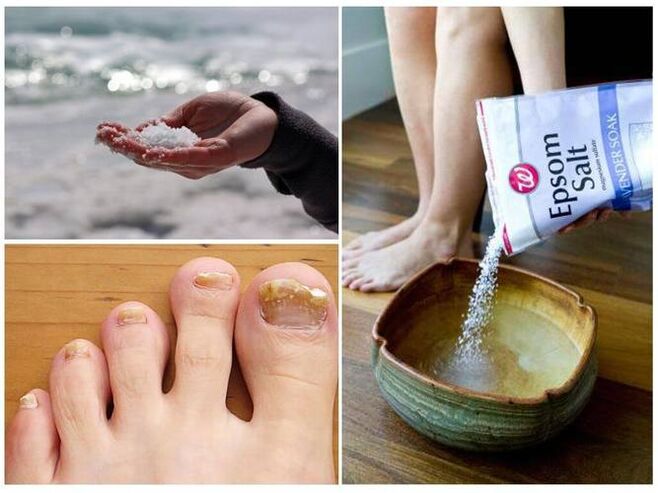
An artificial ointment is applied until the sore nail escapes with the formation of a healthy plate. Alternative therapies are really effective, but the only drawback of their use is the timing of therapy.
The period of use should be at least 3 months. The initial form of fungal infection on the nail plate on the foot can be eliminated in 2 months. In this case, the course of treatment should continue. Skipping even one procedure can worsen tissue health.
Other Methods
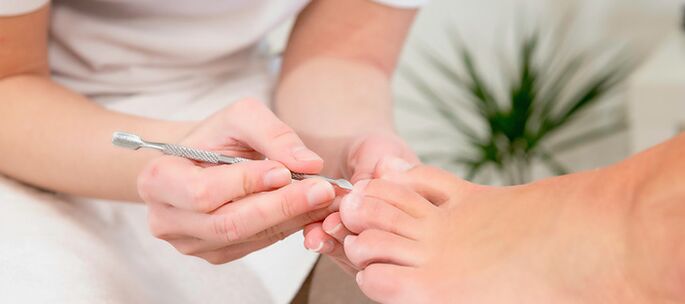
An alternative treatment for fungal infections on the nails on the bottom of the foot is surgery. This method consists of the fact that the treating doctor removes the defective nail plate.
In general, operations are performed as follows:
- The patient freely comes to the operating room, and then lies on the couch or sits in a chair.
- A nurse injects a local anesthetic into a finger, whose nails are affected by onychomycosis.
- Once the anesthetic begins to work (after 5-10 minutes), the surgeon tears the affected nail plate with pliers.
- Antiseptic treatment on the operated area is performed, sutures and sterile bandages are applied.
Upon completion of the surgical intervention, the patient was transferred to his surgical department ward, where he received further therapy with antifungal medication. The average period of complete wound healing is from 7 to 10 days. Within 1 month. new nail plates grow, which, provided the treatment process is properly arranged, have no signs of fungus.
Possible complications
If there is no action aimed at curing nail plate due to fungal infection,may experience the following complications caused by pathogenic microorganisms:
- complete deformation of the nail bed with release further from the base of the bed;
- spread of the fungus to healthy skin tissue located on the surface of the foot, between the toes, the transition of the disease to the nails of the upper part of the foot, the inguinal folds;
- infection with onychomycosis of other family members who have not previously suffered from fungal diseases (children are most vulnerable, because their immune systems are weaker than adults);
- loss of nails and cessation of the process of formation of new plates, because due to the abundance of infectious microorganisms, the structural integrity is initially violated.
Treatment of toenail fungus with folk remedies is possible, but this requires maximum effort, spending at least 3 months. time.
The main danger of onychomycosis is that fungal microorganisms that cause damage to the nail plate are very contagious and quickly adapt to new environmental conditions, as well as the effects of active drug components.
That is why treatment of the disease should be started as early as possible to avoid its transition to a complicated or chronic course form.





























